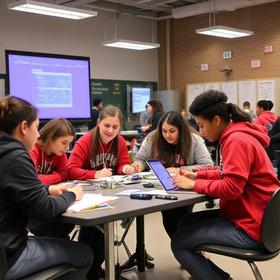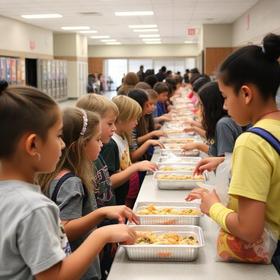Serving 223 students in grades 7-12, Smithton High School ranks in the bottom 50% of all schools in Missouri for overall test scores (math proficiency is bottom 50%, and reading proficiency is bottom 50%).
The percentage of students achieving proficiency in math is 30-34% (which is lower than the Missouri state average of 40%). The percentage of students achieving proficiency in reading/language arts is 40-44% (which is approximately equal to the Missouri state average of 43%).
The student-teacher ratio of 10:1 is lower than the Missouri state level of 12:1.
Minority enrollment is 1% of the student body (majority Black and Hispanic), which is lower than the Missouri state average of 32% (majority Black).
Quick Facts (2025-26)
- Grades: 7-12
- Enrollment: 223 students
- Student-Teacher Ratio: 10:1
- Minority Enrollment: 1%
- Graduation Rate: ≥90% (Top 50% in MO)
- Overall Testing Rank: Bottom 50%
- Math Proficiency: 30-34% (Btm 50%)
- Reading Proficiency: 40-44% (Top 50%)
- Science Proficiency: 30-34% (Btm 50%)
- Source: National Center for Education Statistics (NCES), MO Dept. of Education
Top Rankings
Smithton High School ranks among the top 20% of public schools in Missouri for:
Category
Attribute
Student Attention
School Overview
Smithton High School's student population of 223 students has declined by 20% over five school years.
The teacher population of 22 teachers has declined by 12% over five school years.
Grades Offered
Grades 7-12
(No virtual instruction)
(No virtual instruction)
Total Students
223 students
Gender %
Total Classroom Teachers
22 teachers
School Calendar
School Motto
Encourage · Engage · Educate
School Rankings
Smithton High School ranks within the bottom 50% of all 2,076 schools in Missouri (based off of combined math and reading proficiency testing data).
The diversity score of Smithton High School is 0.02, which is less than the diversity score at state average of 0.51. The school's diversity has stayed relatively flat over five school years.
Overall Testing Rank
#1222 out of 2076 schools
(Bottom 50%)
(Bottom 50%)
Math Test Scores (% Proficient)
30-34%
40%
Reading/Language Arts Test Scores (% Proficient)
40-44%
43%
Science Test Scores (% Proficient)
30-34%
38%
Student-Teacher Ratio
10:1
12:1
American Indian
n/a
n/a
Asian
n/a
2%
Hispanic
n/a
8%
Black
n/a
15%
White
99%
68%
Hawaiian
n/a
1%
Two or more races
1%
6%
All Ethnic Groups
Graduation Rate
≥90%
90%
Eligible for Free Lunch
31%
42%
Eligible for Reduced Lunch
5%
7%
School Statewide Testing
School District Name
Source: National Center for Education Statistics (NCES), MO Dept. of Education
Profile last updated: 02/09/2025
Frequently Asked Questions
What is Smithton High School's ranking?
Smithton High School is ranked #1222 out of 2,076 schools, which ranks it among the bottom 50% of public schools in Missouri.
What schools are Smithton High School often compared to?
Smithton High Schoolis often viewed alongside schools like Smith-cotton High School, Green Ridge High School by visitors of our site.
What percent of students have achieved state testing proficiency in math and reading?
30-34% of students have achieved math proficiency (compared to the 40% MO state average), while 40-44% of students have achieved reading proficiency (compared to the 43% MO state average).
What is the graduation rate of Smithton High School?
The graduation rate of Smithton High School is 90%, which is equal to the Missouri state average of 90%.
How many students attend Smithton High School?
223 students attend Smithton High School.
What is the racial composition of the student body?
99% of Smithton High School students are White, and 1% of students are Two or more races.
What is the student-teacher ratio of Smithton High School?
Smithton High School has a student ration of 10:1, which is lower than the Missouri state average of 12:1.
What grades does Smithton High School offer ?
Smithton High School offers enrollment in grades 7-12 (No virtual instruction).
What school district is Smithton High School part of?
Smithton High School is part of Smithton R-VI School District.
School Reviews
Review Smithton High School. Reviews should be a few sentences in length. Please include any comments on:
- Quality of academic programs, teachers, and facilities
- Availability of music, art, sports and other extracurricular activities
Recent Articles

The Impact of Social Media on Students – 2025 Updated Insights
Explore how social media affects students’ academic performance, behaviour and wellbeing in 2025 with expert insights and policy updates.

The Push for Career and Technical Education (CTE) in 2025
Discover how CTE is transforming U.S. high schools and colleges in 2025: new policies, updated data and best practices for students and educators.

School Lunch Programs: A 2025 Update on Past and Present
Explore the evolution of U.S. school lunch programs, updated for 2025—policy, participation, nutrition, and how schools serve students today.









